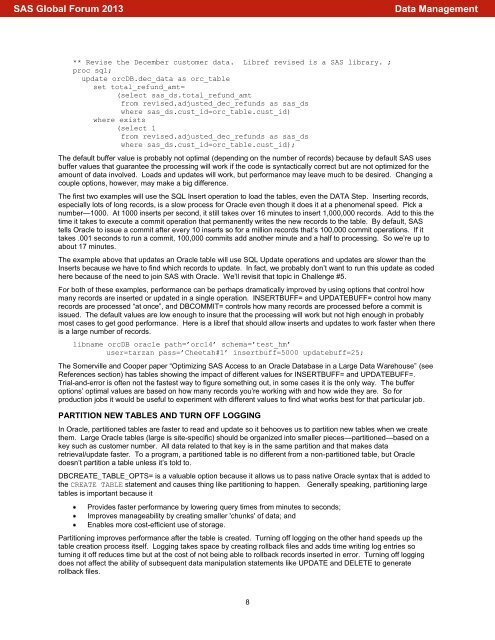072-2013: SAS-Oracle Options and Efficiency: What You Don't Know ...
072-2013: SAS-Oracle Options and Efficiency: What You Don't Know ...
072-2013: SAS-Oracle Options and Efficiency: What You Don't Know ...
You also want an ePaper? Increase the reach of your titles
YUMPU automatically turns print PDFs into web optimized ePapers that Google loves.
<strong>SAS</strong> Global Forum <strong>2013</strong><br />
Data Management<br />
** Revise the December customer data. Libref revised is a <strong>SAS</strong> library. ;<br />
proc sql;<br />
update orcDB.dec_data as orc_table<br />
set total_refund_amt=<br />
(select sas_ds.total_refund_amt<br />
from revised.adjusted_dec_refunds as sas_ds<br />
where sas_ds.cust_id=orc_table.cust_id)<br />
where exists<br />
(select 1<br />
from revised.adjusted_dec_refunds as sas_ds<br />
where sas_ds.cust_id=orc_table.cust_id);<br />
The default buffer value is probably not optimal (depending on the number of records) because by default <strong>SAS</strong> uses<br />
buffer values that guarantee the processing will work if the code is syntactically correct but are not optimized for the<br />
amount of data involved. Loads <strong>and</strong> updates will work, but performance may leave much to be desired. Changing a<br />
couple options, however, may make a big difference.<br />
The first two examples will use the SQL Insert operation to load the tables, even the DATA Step. Inserting records,<br />
especially lots of long records, is a slow process for <strong>Oracle</strong> even though it does it at a phenomenal speed. Pick a<br />
number—1000. At 1000 inserts per second, it still takes over 16 minutes to insert 1,000,000 records. Add to this the<br />
time it takes to execute a commit operation that permanently writes the new records to the table. By default, <strong>SAS</strong><br />
tells <strong>Oracle</strong> to issue a commit after every 10 inserts so for a million records that’s 100,000 commit operations. If it<br />
takes .001 seconds to run a commit, 100,000 commits add another minute <strong>and</strong> a half to processing. So we’re up to<br />
about 17 minutes.<br />
The example above that updates an <strong>Oracle</strong> table will use SQL Update operations <strong>and</strong> updates are slower than the<br />
Inserts because we have to find which records to update. In fact, we probably don’t want to run this update as coded<br />
here because of the need to join <strong>SAS</strong> with <strong>Oracle</strong>. We’ll revisit that topic in Challenge #5.<br />
For both of these examples, performance can be perhaps dramatically improved by using options that control how<br />
many records are inserted or updated in a single operation. INSERTBUFF= <strong>and</strong> UPDATEBUFF= control how many<br />
records are processed “at once”, <strong>and</strong> DBCOMMIT= controls how many records are processed before a commit is<br />
issued. The default values are low enough to insure that the processing will work but not high enough in probably<br />
most cases to get good performance. Here is a libref that should allow inserts <strong>and</strong> updates to work faster when there<br />
is a large number of records.<br />
libname orcDB oracle path=’orcl4’ schema=’test_hm’<br />
user=tarzan pass=’Cheetah#1’ insertbuff=5000 updatebuff=25;<br />
The Somerville <strong>and</strong> Cooper paper “Optimizing <strong>SAS</strong> Access to an <strong>Oracle</strong> Database in a Large Data Warehouse” (see<br />
References section) has tables showing the impact of different values for INSERTBUFF= <strong>and</strong> UPDATEBUFF=.<br />
Trial-<strong>and</strong>-error is often not the fastest way to figure something out, in some cases it is the only way. The buffer<br />
options’ optimal values are based on how many records you’re working with <strong>and</strong> how wide they are. So for<br />
production jobs it would be useful to experiment with different values to find what works best for that particular job.<br />
PARTITION NEW TABLES AND TURN OFF LOGGING<br />
In <strong>Oracle</strong>, partitioned tables are faster to read <strong>and</strong> update so it behooves us to partition new tables when we create<br />
them. Large <strong>Oracle</strong> tables (large is site-specific) should be organized into smaller pieces—partitioned—based on a<br />
key such as customer number. All data related to that key is in the same partition <strong>and</strong> that makes data<br />
retrieval/update faster. To a program, a partitioned table is no different from a non-partitioned table, but <strong>Oracle</strong><br />
doesn’t partition a table unless it’s told to.<br />
DBCREATE_TABLE_OPTS= is a valuable option because it allows us to pass native <strong>Oracle</strong> syntax that is added to<br />
the CREATE TABLE statement <strong>and</strong> causes thing like partitioning to happen. Generally speaking, partitioning large<br />
tables is important because it<br />
Provides faster performance by lowering query times from minutes to seconds;<br />
Improves manageability by creating smaller 'chunks' of data; <strong>and</strong><br />
Enables more cost-efficient use of storage.<br />
Partitioning improves performance after the table is created. Turning off logging on the other h<strong>and</strong> speeds up the<br />
table creation process itself. Logging takes space by creating rollback files <strong>and</strong> adds time writing log entries so<br />
turning it off reduces time but at the cost of not being able to rollback records inserted in error. Turning off logging<br />
does not affect the ability of subsequent data manipulation statements like UPDATE <strong>and</strong> DELETE to generate<br />
rollback files.<br />
8
















